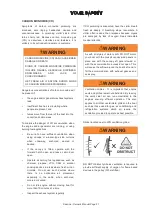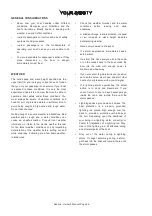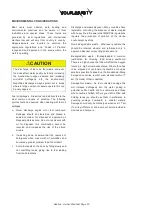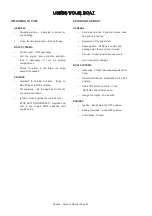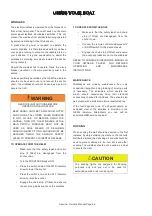
<2856$)(7<
6HDOLQH2ZQHUV0DQXDO3DJH
Noise
-
Generator
designs
now
incorporate
soundproofing and shields of various types, however,
generator noise can still be heard in quiet anchorages.
Exhaust emissions - It is essential to service engines
regularly to keep them operating at their optimum
efficiency. Regular servicing will reduce the engine's
potential to create adverse environmental impacts.
When the main engines have started and warmed up,
check the emissions from the exhausts, if the
emissions are smoky grey or black in colour, then the
engine(s) may need attention.
Apart from being harmful to the environment, such
emissions indicate that the engine is not performing
efficiently, increasing fuel consumption and reducing
performance. The most common cause of poor
exhaust emissions are dirty or un serviced injectors
and fuel pumps.
Refrigeration and freezer gasses - To comply with
legislative changes all fridge and freezer systems now
contain specialist refrigerant gasses. In order that your
fridge freezer functions correctly you must:
a
Ensure that the system is refilled with the
same gas or an OEM approved alternative.
b
Avoid damage to the pipe work which could
cause loss of gas to atmosphere.
c
Ensure that only certified individuals work on
your system.
Wake, wash and environment damage - Excessive
wake from your craft can impact on the shoreline,
eroding soft riverbanks and causing failures of flood
and sea defences.
Coral - If you must anchor in a reef area choose a flat
bottom and avoid coral heads which could be fouled by
the anchor chain as the craft swings.
ANTIFOULING
Antifouling paint keeps away unwanted marine growth
on the underwater parts of the craft. However the very
action of the paint is damaging to the environment
because of the poisons incorporated in the paint.
Tributyl-tin (TBT) antifouling has been banned and
has been replaced with copper based products which
have less harmful effects to the ecosystem.
The following point should be observed when using
antifoul paint:
a Select the right antifouling that does not contain
TBT and that it has the appropriate level of
toxicity for local conditions, the number of coats
needed and the active life of the product.
b
Follow
the
manufacturer's
instructions
for
application and disposal.
c Clean off antifouling as far from the waters edge
as possible to prevent ingress of scraping or dust
blowing into the water. Place a dust sheet under
the craft's hull or use a vacuum scraper.
d Collect and dispose of the scrapings and used
antifoul containers safely in designated bins or
disposal points.
SOLVENTS
Under EC regulations all EU countries should have
phased out the use of CIFC and Trichloroethylene
solvents
containing
Hydrochlorofluorcarbons
(HCFC's) by the year 2015.
When handling solvents the following points should
be observed:
a Tight fitting seals should be used on all storage
containers to prevent evaporative loss of any
Volatile Organic Compounds from substance
such as solvents and paint thinners.
b This should also include containers used for
soiled rags/cloths.
c Clean off unwanted paint before it dries.
d When cleaning engine and machinery parts try
to use paraffin based agents as opposed to
organic solvents.
Summary of Contents for S450
Page 1: ... ...
Page 2: ... ...
Page 6: ... 6HDOLQH 2ZQHU V 0DQXDO 3DJH ...
Page 55: ... 75 6HDOLQH 2ZQHU V 0DQXDO 3DJH AC PANEL 10 10 16 10 16 16 16 16 16 10 16 10 ...
Page 81: ... 7 1 6HDOLQH 2ZQHU V 0DQXDO 3DJH ...
Page 82: ... 6HDOLQH 2ZQHU V 0DQXDO 3DJH DATA SHEETS DIAGRAMS PRINCIPAL DIMENSIONS ...
Page 84: ... 6HDOLQH 2ZQHU V 0DQXDO 3DJH DECK PLAN ...
Page 86: ... 6HDOLQH 2ZQHU V 0DQXDO 3DJH SYSTEM CONTROL POINTS ...
Page 88: ... 6HDOLQH 2ZQHU V 0DQXDO 3DJH EQUIPMENT LOCATION ACCOMMODATION SPACE ...
Page 90: ... 6HDOLQH 2ZQHU V 0DQXDO 3DJH GAS SYSTEM LAYOUT ...
Page 92: ... 6HDOLQH 2ZQHU V 0DQXDO 3DJH FIRE PROTECTION SYSTEM 3 4 1 5 6 8 1 2 7 8 8 1 ...
Page 94: ... 6HDOLQH 2ZQHU V 0DQXDO 3DJH BLACK WATER SYSTEM ...





